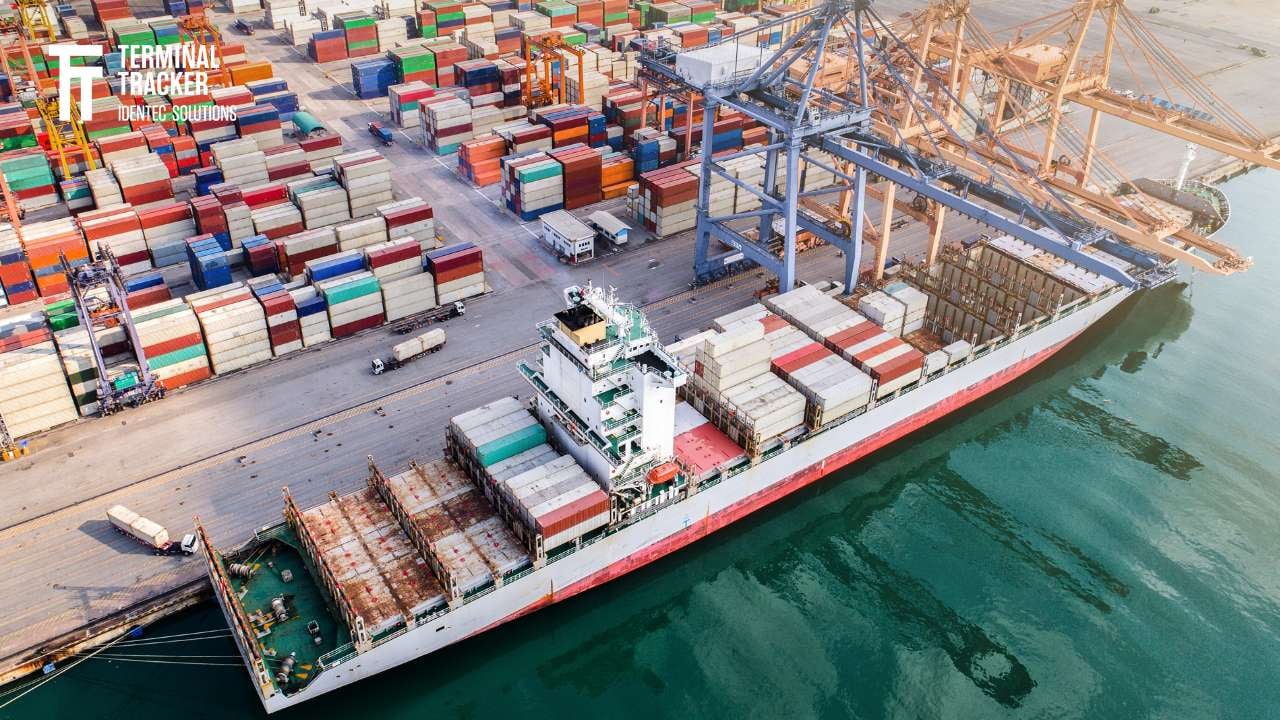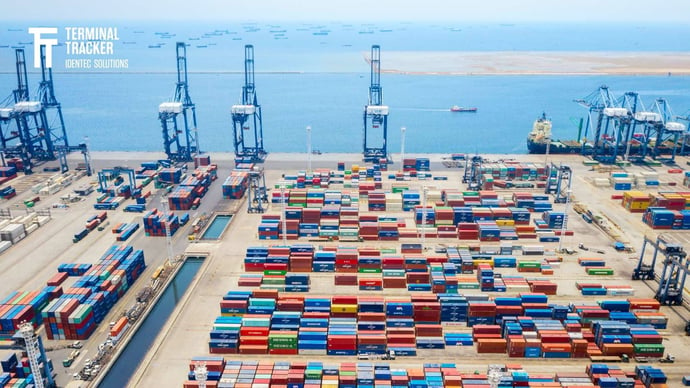Operations reliability and the role of IT at container terminals
| Written by Mark Buzinkay

No video selected
Select a video type in the sidebar.
"Automation in container terminals drastically improves operational reliability and efficiency by minimising human error and optimising the handling processes, ensuring that every container moves seamlessly from ship to shore and reverse."
Julian Galvis, Regional Head Americas
WHy is Operations reliability essential in times of global supply chains?
As global shipping has grown rapidly in the last 40 years, and at the same time, container ship size has increased in recent years due to shipbuilding technology and the idea of economy of scale, container terminals had to follow the trend and improve their facilities continuously. Bigger ships, like the currently biggest vessel, the MSC Irina, with 24,346 TEU (1), mean more containers in peak times, putting stress on port infrastructure and workforce to keep a tight schedule for unloading and loading these giant ships.
However, more boxes at once create more complicated loading and unloading plans for ports. Moreover, the inefficient transfer of containers from the ship to the loading area is a significant problem faced in container-handling facilities. In total, 3928 million twenty equivalent units (TEUs) were carried out on the northwestern European container ports in 2019. This is an increase of 34% compared to the volumes in 2010, emphasizing the importance of container transportation for the international market. Clearly, the focus of improving efficiency was put on container terminal logistics.
What are the
contributing factors to
Operations reliability?
Ports are constantly facing the challenges of uncertainty in services, which leads to disruptions in meeting the needs of their customers. The main source of this uncertainty is the schedule variability of deep-sea vessels, which can lead to changes in the time and order of container arrivals. This disrupts the planned stacking area for inbound and outbound containers and makes it difficult for port operators to allocate the proper resources for each container. As a result, operational efficiency is decreased, and competitiveness among ports is lowered. In order to overcome these challenges, ports must develop new strategies for handling customer demand that are more flexible and adaptable to changing conditions.
Some of the challenges to the container terminals' operations reliability are:
-
Uncertainty of ships' exact arrival time (in general, the planners of a container terminal can plan QCs/YCs worklist only a few hours prior to vessel arrivals);
-
Container terminal operators are unable to process further container transport modes (they don't know if the containers are going further with another deep-sea vessel, barge, rail, or road transport);
-
Most importantly, if they use more SCs at peak times, there will be congestion.
To overcome these challenges, terminals should consider using a dynamic unloading/loading planning procedure to minimize SCs queuing or disarranging and to maximize the container terminal's overall equipment effectiveness (learn also how to optimize bulk handling). This will help ensure that containers are transported promptly and efficiently. Additionally, container handling equipment must coordinate their activities dynamically and adaptively. Therefore, IT support in the form of IIoT is necessary. Learn more about predictive planning in ports.

Operations reliability and container handling equipment
There are many ways to improve port terminal operations, but one of the most important is to ensure the harmony of different container-handling equipment. By coordinating the use of quay cranes (QCs), container transportation vehicles (CTVs), straddle carriers (SCs), and yard cranes (YCs), it is possible to improve efficiency and avoid potential bottlenecks greatly.
One way to optimize efficiency is to schedule when each type of equipment will be used carefully. For example, QCs can be used for unloading containers from ships, while CTVs can be used for transporting containers around the terminal. SCs and YCs can then be used to load and unload containers onto trucks or trains.
It is also essential to make sure that the different types of equipment are compatible with each other. For example, QCs and CTVs should be able to communicate with each other so that containers can be unloaded from ships and then quickly transported around the terminal. Similarly, SCs and YCs should be able to work together so that containers can be efficiently loaded and unloaded. By making sure that all the different types of equipment are compatible with each other, it is possible to improve efficiency further. Overall, this can lead to shorter wait times for ships, faster turnaround times for trucks and trains, and, ultimately, happier customers.
If you want to learn more about how to upgrade your running terminal into a semi-automated terminal, continue reading this post about an automation project.
Operations reliability and IT
As your container terminal grows, so do the number of containers, assets and people you need to manage. To keep things running smoothly, you need a digital assistant that can help you plan and schedule your operations. Look for a solution that is designed to integrate into your container terminal's IT landscape, making it a core part of your operations. You should be able to plan shifts in advance, adjust and reserve vehicles and workforce, and easily promote jobs. Thanks to its plug-and-play compatibility with your TOS and easy installation by a Professional Services team, the perfect solution for busy terminals streamlines operations rather than makes them unflexible.
A job promotion functionality is essential for operational reliability and safety as it automatically gives tasks to container handling equipment, identifies trucks and eliminates the need for drivers to search through a long job list (see also: Container handling trucks TOS integration). Real-time location data is also critical for ensuring efficient and safe operations as it allows for the semi-automation of processes such as handover between cranes and CHE or external haulage control. With the control of twist-locks, no unexpected container moves are permitted, making lost containers a thing of the past and giving you real-time data at the gate, yard, and quay. Such an advanced system also allows you to control access to your terminal, dedicated zones and vehicles. By optimizing crane usage, box movements and vehicle traffic, your IT ensures safe and efficient container handling and operations reliability for all stakeholders: dockers, management, and clients.
Read more about Port Position Detection System
FAQ
What is a reliability engineer, and what is his job at a container terminal?
The primary role of the reliability engineer is to identify and manage the reliability risks for facilities such as container terminals. The role has three pillars: loss elimination, risk management, and life cycle asset management (LCAM).
Loss elimination
The basis for this is the preparation of the relevant data in order to track and analyse production losses and equipment with unusually high maintenance costs in order to find then ways to reduce these losses and high costs.
The losses are prioritised, with those with the most significant impact being targeted first, as this is where the highest savings are expected. A concept is developed in collaboration with the operations team, and the reliability engineer is also involved in its implementation.
Risk management
Other areas whose risks must be clarified and monitored are productivity, quality and customer satisfaction, as well as plant safety and environmental protection efforts.
Various tools exist for recording and analysing risks, such as maintenance information (MI), preliminary hazard analysis (PHA), or failure modes and effects analysis (FMEA).
Life Cycle Asset Management
Reliability engineers must be involved in projects related to the integration of new assets or the modification of existing assets, as the life cycle cost (LCC) must be determined before the asset is put into operation.
At container terminals, reliability engineers are involved in:
Equipment Maintenance and Reliability
Cranes, container handling equipment (CHE), and vehicles must function reliably to minimise downtime and disruptions.
Predictive Maintenance
The necessary precautions must be taken so that sensors and data analysis can be used to predict when equipment is likely to fail to be able to proactively counteract this with maintenance work and repairs.
Failure Analysis
All equipment failures that occur despite predictive maintenance must undergo a root cause analysis to prevent future incidents and optimise predictive maintenance.
Optimisation of Operations
In collaboration with other departments, the operating data is analysed to determine where the performance and efficiency of terminal operations can be further optimised through greater reliability.
Safety and Compliance
All equipment must comply with safety standards and legal requirements everywhere and at all times, while measures must be developed to prevent accidents and incidents.
Takeaway
Operational reliability at container terminals can be increased with the help of IT in a number of ways. One way is by automating processes and tasks that are currently manual, error-prone, and time-consuming. This can help to eliminate human errors and improve efficiency. Investing in real-time data tracking and analysis is another way to use IT to improve operational reliability. This can help managers to identify potential problems and issues early on before they cause disruptions to operations. Finally, implementing a comprehensive maintenance management system can also help to improve operational reliability by ensuring that all equipment is adequately maintained and serviced. Container terminals can improve their overall reliability and avoid costly disruptions by taking these steps and heading towards port terminal automation.
Dive deeper into one of our core topics and learn more about: Smart Port
Glossary
Deep-sea vessels are large cargo ships designed for long-distance ocean transport of shipping containers. These vessels typically have a capacity of up to 24,346 TEUs and are equipped with 2-stroke engines for efficient operation across vast oceanic routes. They are built to withstand harsh open-sea conditions and can travel for weeks between major ports. Deep-sea vessels are crucial for global trade, carrying approximately 90% of non-bulk cargo worldwide. (2)
Inbound containers refer to shipping containers arriving at a port or facility, typically carrying imported goods or raw materials. Outbound containers are those leaving a port or facility, usually filled with exported products or finished goods. This distinction is crucial for port operations, logistics planning, and supply chain management. Inbound containers are part of inbound logistics, focusing on receiving and storing goods, while outbound containers are part of outbound logistics, involving order fulfilment and shipping to end customers. (3)
Sources:
(1) https://ship.nridigital.com/ship_jun24/top_10_largest_container_ships
(2) Deep Sea and Foreign Going by Rose George, Portobello Books, 2014
(3) Dictionary of Shipping Terms by Peter Brodie, Routledge, 2013
Note: This article was updated on the 21st of January 2025

Author
Mark Buzinkay, Head of Marketing
Mark Buzinkay holds a PhD in Virtual Anthropology, a Master in Business Administration (Telecommunications Mgmt), a Master of Science in Information Management and a Master of Arts in History, Sociology and Philosophy. Mark spent most of his professional career developing and creating business ideas - from a marketing, organisational and process point of view. He is fascinated by the digital transformation of industries, especially manufacturing and logistics. Mark writes mainly about Industry 4.0, maritime logistics, process and change management, innovations onshore and offshore, and the digital transformation in general.




